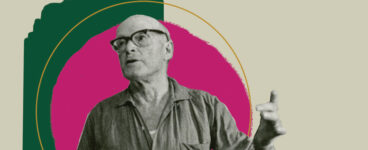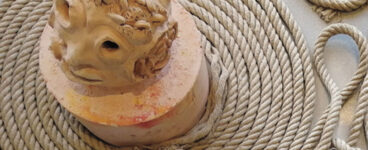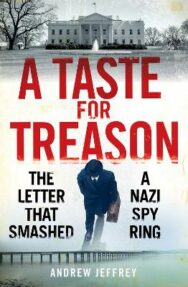Daredevil pilot, wartime fighter ace and ‘resting’ actor Major Christopher Draper told reporters on landing that the flight had been a publicity stunt, partly to get work for himself and partly to highlight the plight of other jobless ex-servicemen reduced to penury by the global recession.
Dundee, 1937. This is the true story of a decade-long series of Nazi espionage plots, centring housewife Mary Curran as she becomes suspicious of her hairdresser Jessie Jordan’s frequent trips to Europe. She would never expect that suspicion would draw her into an international web of espionage. You can read an extract from A Taste for Treason below.
A Taste for Treason
By Andrew Jeffrey
Published by Birlinn
Herzlich Willkommen an Arsch der Welt – A Warm Welcome to the Arsehole of the World Sign at a secret German training airfield, Russia, 1922
– Tower Bridge, London, 30 September 1931
At first the silver wings of the little de Havilland Puss Moth were all but invisible against a leaden grey sky. Then it swooped down, lined up on the twin Gothic towers of Tower Bridge and shot through the gap between the roadway and the iron tracery of the walkway above. As astonished motorists and passers-by looked on, it continued upriver, passing low over the next seven bridges before darting through the central arch of Westminster Bridge and climbing away towards Brooklands aerodrome.
Daredevil pilot, wartime fighter ace and ‘resting’ actor Major Christopher Draper told reporters on landing that the flight had been a publicity stunt, partly to get work for himself and partly to highlight the plight of other jobless ex-servicemen reduced to penury by the global recession. The dramatic one-man protest led to an appearance in court charged with dangerous flying and flying without a valid pilot’s licence. A policeman claimed that the Puss Moth had dropped to within seven feet of the Tower Bridge roadway and that Draper and his cameraman passenger narrowly escaped death as the bridge was about to be raised to allow a ship to pass through. This was nonsense, as Paramount News footage of the flight showed, and Draper was let off with a stern warning. But it was music to the ears of a resting actor dubbed ‘The Mad Major’ by a delighted press as it brought welcome offers of work including a starring role in Aces of the Air, a nationwide tour by wartime British and German airmen delivering homilies on peace and the future of aviation to cinema audiences about to be thrilled by Howard Hughes’ new aviation comedy, Sky Devils.
In the audience when Aces of the Air opened at London’s Plaza cinema on 24 June 1932 was the tour’s promoter, Colonel William Francis Forbes-Sempill. A scion of one of Scotland’s oldest aristo- cratic dynasties and a wartime Royal Naval Air Service veteran, the Master of Sempill had been spying for the Imperial Japanese Navy since leading a naval aviation mission to Tokyo in 1922. Seduced by the militarist fascism of the ultra-nationalist Ko¯ do¯ ha (Way of the Emperor) faction and motivated to treason by an eye-watering bank overdraft, this clever, pushy, egocentric aristocrat was a keen supporter of British fascist organisations like the stridently anti- Semitic National Political League and the Royal Empire Society, a peculiar group that advocated stemming the tide of imperial decline with a programme of ‘planned’ emigration that would increase the Anglo-Saxon gene pool in fractious colonies. Sempill was also, in 1931, one of the founding principals behind the Anglo- German Fellowship, an organisation so rabidly right-wing that Soviet mole Kim Philby joined as effective cover for his own brand of treachery.
Sempill had begun planning the Aces of the Air tour after one of his regular visits to Germany and his shrill advance publicity trumpeted ‘Personal Appearances by Four Famous Air Aces!’ This was certainly warranted in the case of German Eduard Ritter von Schleich, the wartime ‘Black Knight’ who had a Pour le Mérite, or Blue Max, and 35 victories to his credit. ‘Mad Major’ Christopher Draper, fresh from his London bridges flight, had nine victories, so he too could be considered an ace. But Sempill was lying when he tried to pass off army officer Günther von Richthofen as a brother of the late Red Baron, Manfred von Richthofen, and an illustrious airman in his own right. Günther von Richthofen was really only a distant cousin of the Red Baron and no airman. The other British ace, Major Allan Bridgeman, was actually just a shy and unremarkable wartime pilot down on his luck after a messy divorce. It is telling that this was to be a purely Anglo-German affair; no airmen from Britain’s wartime allies, or from Germany’s for that matter, were invited.
Aces of the Air ran for 151 packed performances with the char- ismatic ‘Teddy’ von Schleich, his black uniform aglow with medals, the star turn. A fierce anti-communist who had narrowly escaped death while resisting an attempted Bolshevik coup in Bavaria, von Schleich had been among the first recruits to the nascent Nazi Party and, as Christopher Draper writes:
From him I learned a great deal about the National Socialist Party, and we had long and most interesting discussions, especially because one of our party, who accompanied the tour as a sort of business manager, was a very English Jew. As can be imagined, he and Teddy had the most heated arguments . . . Teddy used to tell me time and again: ‘Christoph, eet eez only a question of time before my Hitler eez zee power.’
Draper subsequently went to Germany as von Schleich’s guest and, on 15 October 1932, was introduced to Hitler at Munich air- port. The Führer seemed bored at first, but brightened on being told by his press agent Ernst Hanfstängl that Major Draper would be making a case for the Nazis in influential circles in London. Quite where ‘Putzi’ Hanfstängl got the idea that a cash-strapped, unem- ployed actor could wield pro-Nazi influence in Britain’s corridors of power is unclear. Perhaps Draper’s association with Sempill had something to do with it and, while this may only be a coincidence, Sempill had visited Germany just a week before Draper arrived in Munich.
Whatever really happened in Germany, Draper was by no means the first gay man to find the Nazis’ pantomime rituals and homo- erotic male bonding strangely appealing and, on 19 March 1933, the Sunday Despatch reported that Major Christopher Draper, recently returned from Munich where he had met Herr Hitler, was organising a nationwide series of talks on behalf of the Nazis. At the end of April, an MI5 mail intercept on Dr Hans Thost, the London correspondent of the Nazi Party newspaper Völkischer Beobachter and a known low-level German spy, turned up an invitation to a meeting in Hampstead at which Draper would speak on the future of fascism in Europe.
A Taste for Treason by Andrew Jeffrey is published by Birlinn, priced £14.99.
ALSO IN THIS ISSUE

 Doras Gun Chlàimhean
Doras Gun Chlàimhean
I did not ever think That you would come home, my love, In a narrow, wooden coffin.

 Scotland’s Transnational Heritage
Scotland’s Transnational Heritage
“There is no one single national history. National histories are not fixed in any particular time or …













